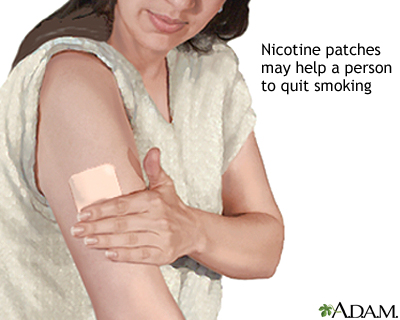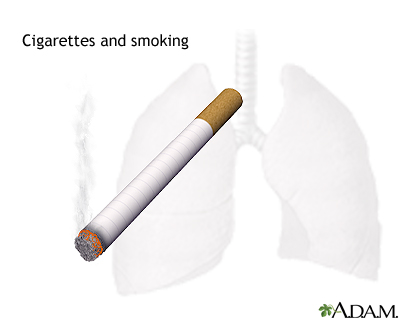There are many ways to quit smoking. There are also resources to help you. Family members, friends, and co-workers may be supportive. But to be successful, you must really want to quit. The tips below can help you get started.
Information
Most people who have quit smoking were unsuccessful at least once in the past. Try not to view past attempts to quit as failures. See them as learning experiences.
It is hard to stop smoking or using smokeless tobacco, but anyone can do it.
Know what symptoms to expect when you stop smoking. These are called withdrawal symptoms. Common symptoms include:
- An intense craving for nicotine
- Anxiety, tension, restlessness, frustration, or impatience
- Difficulty concentrating
- Drowsiness or trouble sleeping
- Headaches
- Increased appetite and weight gain
- Irritability or depression
How bad your symptoms are depends on how long you smoked. The number of cigarettes you smoked each day also plays a role.
FEEL READY TO QUIT?
First, set a quit date. That is the day you will quit completely. Before your quit date, you may begin reducing your cigarette use. Remember, there is no safe level of cigarette smoking.
List the reasons why you want to quit. Include both short- and long-term benefits.
Identify the times you are most likely to smoke. For example, do you tend to smoke when feeling stressed or down? When out at night with friends? While drinking coffee or alcohol? When bored? While driving? Right after a meal or sex? During a work break? While watching TV or playing cards? When you are with other smokers?
Let your friends, family, and co-workers know of your plan to stop smoking. Tell them your quit date. It can be helpful if they know what you are going through, especially when you are grumpy.
Get rid of all your cigarettes just before the quit date. Clean anything that smells of smoke, such as clothes and furniture.
MAKE A PLAN
Plan what you will do instead of smoking at those times when you are most likely to smoke.
Be as specific as possible. For example, if in the past you smoked when drinking a cup of coffee, drink tea instead. Tea may not trigger the desire for a cigarette. Or, when you feel stressed, take a walk instead of smoking a cigarette.
Get rid of cigarettes in the car. Put pretzels or other low calorie healthy snack there instead.
Find activities that focus your hands and mind, but make sure they are not taxing or fattening. Computer games, solitaire, knitting, sewing, and crossword puzzles may help.
If you normally smoke after eating, find other ways to end a meal. Eat a piece of fruit. Get up and make a phone call. Take a walk (a good distraction that also burns calories).
CHANGE YOUR LIFESTYLE
Make other changes in your lifestyle. Change your daily schedule and habits. Eat at different times, or eat several small meals instead of three large ones. Sit in a different chair or even a different room.
Satisfy your oral habits in other ways. Eat celery or another low-calorie snack. Chew sugarless gum. Suck on a cinnamon stick. Pretend-smoke with a straw.
Get more exercise. Take walks or ride a bike. Exercise helps relieve the urge to smoke.
SET SOME GOALS
Set short-term quitting goals and reward yourself when you meet them. Every day, put the money you normally spend on cigarettes in a jar. Later, spend that money on something you like.
Try not to think about all the days ahead you will need to avoid smoking. Take it one day at a time.
Just one puff or one cigarette will make your desire for cigarettes even stronger. However, it is normal to make mistakes. So even if you have one cigarette, you do not need to take the next one.
OTHER TIPS
Enroll in a stop smoking support program. Hospitals, health departments, community centers, and work sites often offer programs. Learn about self-hypnosis or other techniques.
Ask your health care provider about medicines that can help you quit nicotine and tobacco and keep you from starting again. These include nicotine patches, gum, lozenges, and sprays. Prescription medicines that help reduce nicotine cravings and other withdrawal symptoms include varenicline (Chantix) and bupropion (Zyban, Wellbutrin).

The American Cancer Society's website, The Great American Smokeout is a good resource.
The website smokefree.gov also provides information and resources for smokers. Calling 1-800-QUIT-NOW (1-800-784-8669) or 1-877-44U-QUIT (1-877-448-7848) will direct you to a free telephone counseling program in your state.

Above all, do not get discouraged if you are not able to quit smoking the first time. Nicotine addiction is a hard habit to break. Try something different next time. Develop new strategies, and try again. For many people, it takes several attempts to finally kick the habit.
Alternative Names
Cigarettes - tips on how to quit; Smoking cessation - tips on how to quit; Smokeless tobacco - tips on how to quit; Tobacco cessation - tips; Nicotine cessation - tips
Patient Instructions
- Abdominal aortic aneurysm repair - open - discharge
- Angina - discharge
- Angina - what to ask your doctor
- Angioplasty and stent - heart - discharge
- Angioplasty and stent placement - carotid artery - discharge
- Angioplasty and stent placement - peripheral arteries - discharge
- Aortic aneurysm repair - endovascular - discharge
- Brain aneurysm repair - discharge
- Carotid artery surgery - discharge
- Chronic obstructive pulmonary disease - adults - discharge
- Controlling your high blood pressure
- Deep vein thrombosis - discharge
- Diabetes - preventing heart attack and stroke
- Esophagectomy - discharge
- Foot amputation - discharge
- Heart attack – discharge
- Heart attack - what to ask your provider
- Heart bypass surgery - discharge
- Heart bypass surgery - minimally invasive - discharge
- Heart disease - risk factors
- Heart failure - discharge
- Heart valve surgery - discharge
- Leg amputation - discharge
- Lung surgery - discharge
- Peripheral artery bypass - leg - discharge
- Pneumonia in adults - discharge
- Stroke - discharge
Images
References
Atkinson DL, Minnix J, Cinciripini PM, Karam-Hage M. Nicotine. In: Johnson BA, ed. Addiction Medicine: Science and Practice. 2nd ed. Philadelphia, PA: Elsevier; 2020:chap 23.
Brunetta PG, Kroon L. Smoking cessation. In: Broaddus VC, Ernst JD, King TE, et al, eds. Murray and Nadel's Textbook of Respiratory Medicine. 7th ed. Philadelphia, PA: Elsevier; 2022:chap 66.
George TP. Nicotine and tobacco. In: Goldman L, Schafer AI, eds. Goldman-Cecil Medicine. 26th ed. Philadelphia, PA: Elsevier; 2020:chap 29.
US Preventive Services Task Force; Krist AH, Davidson KW, Mangione CM, et al. Interventions for tobacco smoking cessation in adults, including pregnant persons: US Preventive Services Task Force recommendation statement. JAMA. 2021;325(3):265-279. PMID: 33464343 pubmed.ncbi.nlm.nih.gov/33464343/.
Review Date 7/25/2022
Updated by: Linda J. Vorvick, MD, Clinical Professor, Department of Family Medicine, UW Medicine, School of Medicine, University of Washington, Seattle, WA. Also reviewed by David C. Dugdale, MD, Medical Director, Brenda Conaway, Editorial Director, and the A.D.A.M. Editorial team.




